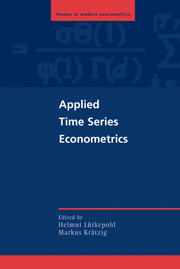Book contents
- Frontmatter
- Contents
- Preface
- Notation and Abbreviations
- List of Contributors
- 1 Initial Tasks and Overview
- 2 Univariate Time Series Analysis
- 3 Vector Autoregressive and Vector Error Correction Models
- 4 Structural Vector Autoregressive Modeling and Impulse Responses
- 5 Conditional Heteroskedasticity
- 6 Smooth Transition Regression Modeling
- 7 Nonparametric Time Series Modeling
- 8 The Software JMu⌉Ti
- References
- Index
6 - Smooth Transition Regression Modeling
Published online by Cambridge University Press: 23 November 2009
- Frontmatter
- Contents
- Preface
- Notation and Abbreviations
- List of Contributors
- 1 Initial Tasks and Overview
- 2 Univariate Time Series Analysis
- 3 Vector Autoregressive and Vector Error Correction Models
- 4 Structural Vector Autoregressive Modeling and Impulse Responses
- 5 Conditional Heteroskedasticity
- 6 Smooth Transition Regression Modeling
- 7 Nonparametric Time Series Modeling
- 8 The Software JMu⌉Ti
- References
- Index
Summary
Introduction
Nonlinear models have gained a foothold in both macroeconomic and financial modeling. Linear approximations to nonlinear economic phenomena have served macroeconomic modelers well, but in many cases nonlinear specifications have turned out to be useful. Nonlinear econometric models can be divided in two broad categories. The first one contains the models that do not nest a linear model as a special case. Disequilibrium models [e.g., Fair & Jaffee (1972)] are a case in point. The second category embraces several popular models that do nest a linear model. The switching regression model, various Markov-switching models, and the smooth transition regression model are examples of models that belong to this class. Researchers interested in applying them can then choose a linear model as their starting-point and consider nonlinear extensions should they turn out to be necessary. In this chapter, the discussion is centered on modeling of economic time series using the family of smooth transition regression models as a tool.
This chapter is organized as follows. The smooth transition regression model is presented in Section 6.2. The modeling cycle, consisting of specification, estimation and evaluation stages, is the topic of Section 6.3. In Section 6.4, the modeling strategy and its application using JMu⌉Ti is illustrated by two empirical examples. Section 6.5 presents some final remarks.
The Model
The smooth transition regression (STR) model is a nonlinear regression model that may be viewed as a further development of the switching regression model that Quandt (1958) introduced. The univariate version of the switching regression model has long been known as the threshold autoregressive model; for a thorough review, see Tong (1990).
- Type
- Chapter
- Information
- Applied Time Series Econometrics , pp. 222 - 242Publisher: Cambridge University PressPrint publication year: 2004
- 79
- Cited by



